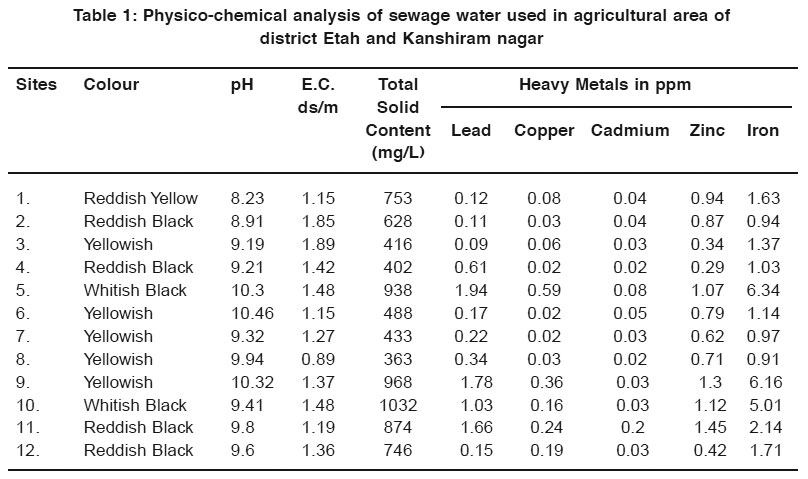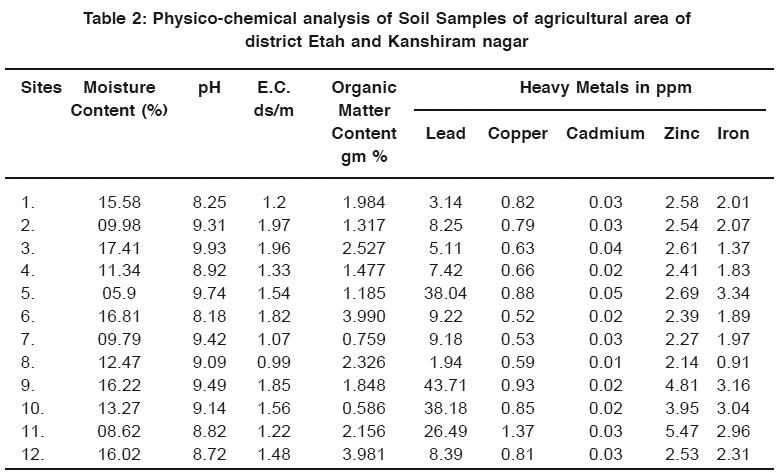Accumulation of heavy metal in agricultural field irrigated with sewage water in industrial and Municipal area
R.K. Pandey1 and Amit Dwivedi1 *
1
Department of Chemistry & Industrial Chemistry,
PG College,
Ganjdundwara,
207242
India
DOI: http://dx.doi.org/10.12944/CWE.4.2.22
A study was carried out in agricultural areas near industrial and urban areas of district Etah and Kanshiram nagar during the year 2007-2008 to access the nature and extent of soil with heavy metals due to use of industrial and municipal sewage water for irrigation. Due to easy and chargeless source of water, farmers of sampling areas use sewage water for irrigation purpose. The sewage water samples were scrutinized for colour, PH, electrical conductance, total solid content and for heavy metals. The samples of soil irrigated by sewage water were scrutinized for moisture content , PH, electrical conductance, organic matter and for heavy metals. All areas under study have moisture content, PH, electrical conductance, organic matter and for heavy metals as lead copper, cadmium, Zinc and iron were not observed above toxic level.
Copy the following to cite this article:
Pandey R.K, Dwivedi A. Accumulation of heavy metal in agricultural field irrigated with sewage water in industrial and Municipal area. Curr World Environ 2009;4(2):405-408 DOI:http://dx.doi.org/10.12944/CWE.4.2.22
Copy the following to cite this URL:
Pandey R.K, Dwivedi A. Accumulation of heavy metal in agricultural field irrigated with sewage water in industrial and Municipal area. Curr World Environ 2009;4(2):405-408. Available from: http://www.cwejournal.org/?p=998
Download article (pdf) Citation Manager Publish History
Select type of program for download
| Endnote EndNote format (Mac & Win) | |
| Reference Manager Ris format (Win only) | |
| Procite Ris format (Win only) | |
| Medlars Format | |
| RefWorks Format RefWorks format (Mac & Win) | |
| BibTex Format BibTex format (Mac & Win) |
Article Publishing History
| Received: | 2009-10-25 |
|---|---|
| Accepted: | 2009-12-01 |
Introduction
Soil is essential for the survival of the living world, especially for human population. Wrong agricultural practices deteriorate the soil quality Rapid industrialization and urbanization during recent years have threatened the soil environment through consequences of pollution.1 The physico- chemical and biological properties of soil govern the gaseous balance, water transfer, plant growth and decomposition of complex organic substance in it. Any alternation in these properties due to different types of pollution leads to change in fertility of soil.2
Crop plants grown in the agricultural fields by using municipal and industrial sewage waste water are adversely affected both qualitatively and quantitatively. Impact of sewage waste water on agricultural crop plants has been studied earlier by several workers.3-6 In the present study an attempt has been made to find out concentration of heavy metals in soil of agricultural fields situated nearly industrial & urban areas and irrigated by sewage water in distr ict Etah and Kanshiram nagar (Kasganj). The crops here, are grown in such agricultural fields which are receive untreated water of industrial and municipal sewage. In our country, deficiency of sewage treatment plants, generally untreated sewage effluents are freed pollution on agricultural land for irrigation. Discarding of industrial waste in the for most problem leable for soil pollution. In general, sewage generated from industries7 and municipal origin contain considerable amounts of plants nutrients8 and erratic amount of metallic cation9 like Zinc, Copper, Iron etc. Long term regular use of such effluent on agricultural land electrical conductance, organic carbon content and heavy metals accumulation in soil10,11,12 increasing the probabilities of their doorway in food chain13, may result in to phytotoxicity of the crop plant being grown.14
Heavy metals uptake by plant grown in polluted soils (Mostly from anthropogenic activities such as sewage sludge application) has been studied to a considerable extent.15 Elevated levels of heavy metals in soil may lead to uptake by plant but there is not generally found high relationship between the concentration in soil, and plants,because it depends on many different factors such as soil metal bioavailability, plant growth and metal distribution to plant parts. Consequently element mobility and plant availability are very important when assessing the effect of soil contamination on plant metal uptake and related phytotoxic effects. Interactions between metals occurring at the root surface and with in the plant can effect up take as well as translocation and toxicity.16 High concentration of heavy metals in the soil disrupt physiologically important functions in plants, causes an imbalance of nutrients and have an adverse effect on the synthesis and functioning of many biologically important compounds such as enzymes, vitamins and hormones.17 The purpose of this study was to determine the pollution load of sewage water on agricultural soil and to determine the distribution of heavy metals in agricultural soils irrigated by industrial and municipal sewage waste water.
Experimental
The complete area of study is located in district Etah and Kanshiram nagar of Utter Pradesh. For the selection of soil and sewage water sample 12 sites were selected. Collected samples were analysed by employing standard methods.19, 20, 21
The sewage water used in agricultural areas of selected sites were collected in HDPE bottles and analyzed for some physico-chemical parameters viz: colour, PH, conductivity, Totel solid content and heavy metals as lead, copper, zinc, cadmium and iron.
Soil Analysis
For this investigation soil samples were collected from 12 different sites of district Etah and Kanshiram nagar. The soil samples were stored in polythene bags. The collected soil, samples were analysed for some physico-chemical properties as, moisture content, pH, electricial conductance, organic matter and heavy metals as lead, copper, zinc, cadmium and iron.
Results and Discussion
(A) Water Samples
For the sewage water analysis the water samples were collected from different industrial and municipal nalla where the agricultural field are irrigated. Physico-chemical properties of sewage water samples are presented in Table 1.
 |
Table 1: Physico-chemical analysis of sewage water used in agricultural area of district Etah and Kanshiram nagar Click here to view table |
Colour and Odour
Sewage water collected having pungent and unpleasant odour. The sewage water collected from site 1 was reddish yellow in colour, collected from sites 2,4,11&12 were reddish black in colour, collected from sites 3,6,7,8&9 were yellowish in colour and the sewage water collected from selected site no. 5&10 were whitish black in colour.
PH
The pH of waste water collected from selected sites ranged between 8.23 to 10.46.
Electrical Conductivity
The electrical conductivity of the sewage water was found in ranged between 0.89 ds/m to 1.89 ds/m.
Totel Solid Content
The total solid content in side the sewage water were found from 363 mg/L to 1032 mg/L.
Heavy Metal Analysis of Water
Heavy metal analysis of sewage water used in agricultural field was carried out, results as follows:
• Lead concentration varying from 0.09 ppm to 1.94 ppm.
• Copper concentration varying from 0.02 ppm to 0.59 ppm.
• Cadmium concentration varying from 0.08 ppm to 0.20 ppm.
• Zinc concentration varying from 0.29 ppm to 1.45 ppm.
• Iron concentration varying from 0.91 ppm to 2.14 ppm.
(B) Soil Samples
Soil samples collected from the selected 12 sites. The result of analysis of the physico- chemical properties in soil sample are presented in Table 2. The moisture content of the soil samples was found between 5.9% to 17.41%. The pH of soil varied from 8.18 to 9.93. The electrical conductivity ranged from 0.99 ds/m to 1.97 ds/m. The organic matter content of soil ranged between 0.586 gm% to 3.99 gm%. The present status of heavy metal was carried out, Lead concentration varied 1.94 ppm to 43.71 ppm. Copper concentration varied from 0.52 ppm to 1.37 ppm. Cadmium concentration varied from 0.01 ppm to 0.05 ppm In soil. Zinc concentration varied from 2.14 ppm to 5.47 ppm and Iron concentration varied from 0.9 ppm to 3.34 ppm in the soil.
 |
Table 2: Physico-chemical analysis of Soil Samples of agricultural area of district Etah and Kanshiram nagar Click here to view table |
In the present study an investigation has been developed; The study of soil PH is important since it controls the microbial actions in the soil (18). The soil PH was not highly influenced by sewage water. However soil PH may influence nurtient adsorption and growth of plant. The results denotes that long ter m use of these water increasing electrical conductivity of soil and may create salinity problem. The organic matter content is automatically increased with the use of sewage water. The concentrations of lead, copper, cadmium, zinc and iron ranged 1.94 to 43.71, 0.52 to 1.37, 0.01 to 0.05, 2.14 to 5.47, and 0.91 to 3.34 ppm respectively and show proper soil quality for crop production.
It is well known fact that, the lead is a slow poison causing acute and different serious chronic disease in human body. Long term effect of chronic lead toxicity comprises hyperactivity, renal, anemia, liver & brain damage. Zinc compounds are serious for skin, eyes and cause zinc pox demarits specially. Copper is so essential element for human metabolism, some enzymes and for the R.B.C. formation but the value of copper above 1.5 ppm causes liver damage. Cadmium at low concentration is no toxic for human & plant if the concentration of cadmium to slightly high causes leaf chlorosis in plant and toxic to animal in food chain.
Conclusion
The present study of heavy metals in sewage water and soil of sewage irrigated field, were not observed to exceed limits of heavy metal. However for the health of human, animal and plant the entry of heavy metal in food chain should be prohibited and the entry of harmful element in food chain should be controlled. The study shown that with regular monitoring and proper management, sewage water could be used for irrigation purpose.
Acknowledgements
The author Amit Dwivedi is thank full to the Head department of chemistry. P.G. college Ganjdundwara and Dr. V.D. Vashishtha (Ex. Argi. Director Raj. Govt.) for giving their valuable suggestions and possible laboratory facilities.
References
- Sukumaram, G.B. Shivkumar, E.K.T. and Trivedi R.K.; Industrial Poll. Control (2001) 17 (2):25-238.
- Sastry, K.V., Shukla, V., Abusaria, S. and Pankaj Gill; Poll. Res.(2001) 20 (2): 187-192.
- Angade, S.B.and Mathad, P.; J. Environ. Boil.(1998) 19(2): 119-124.
- Carlson R.W. Bazaaz F.A. and Rolfe G.L.; Environ, Res,(1975) 10: 113-120.
- Khan, T.I., Kaur N. and Agrwal N.; J. Envi. And Pollution (1997) 4(1) : 35-38.
- Maury A.M., Gupta R.K. and Gupta A.K., Indian J. Environ. Health (1986) 29(2), 134-139.
- Volesky, B., FEMS Microbiology Reviews,(1994)14: 291.
- Sreeramulu, U.S.; J. Ind. Soc. Soil, Sce (1994) 42(4): 525-532.
- Kansal, F.L.; Parwana, H.K. and Verma, S.P., Ind. J. Environ, Prot, (1993) 13: 374.
- Olaniya, M.S., et al., Indian J. Environ Health,(1998) 40(2): 160-168.
- Brar, M.S. and Arora, C.L., Indian, J. Agri. Sci (1997) 67: 141-143.
- Narwal, R.P.; Gupta, A.P.; Singh, A. and Karsawa S.P.S., Ann, Biol.(1993) 9: 239-245.
- Anderson, A.; and Nilsson, K.O.; Ambio,(1973) 1: 176-179.
- Sharma Yogesh and Totawot, K.L., Proc. XI National Symoposium on Environment 320-322 (2002).
- Gigliotte, G,; Businele, D,; Ginsquioni, P.; Agric, Ewsyst. Environ.(1996) 58:199-206.
- Mench, M.; Vangransveld J., Divier, V; Clejstar, D.; Environ, Pollute.(1994) 86: 279-286.
- Luo, Y.; Rimmer, D.; Environ. Pollute.(1995) 88: 79-83.
- Hesse, P.R., Soil chemical analysis, John Murray, London (1971).
- Trivedi; R.K.; Goel; P.K; and Trisal,C.L. Practical Methods in Ecology and environmental Science. Enviro Media; Karad, India (1987).
- Tandon; H.L.S. Methods of Analysis of soil, plants, water and fer tilizers. Fer tilizers development and consultation organization, New delhi (1993)
- Tessler; A.; et al., Anal Chem.(1979) 51: 884-850.







